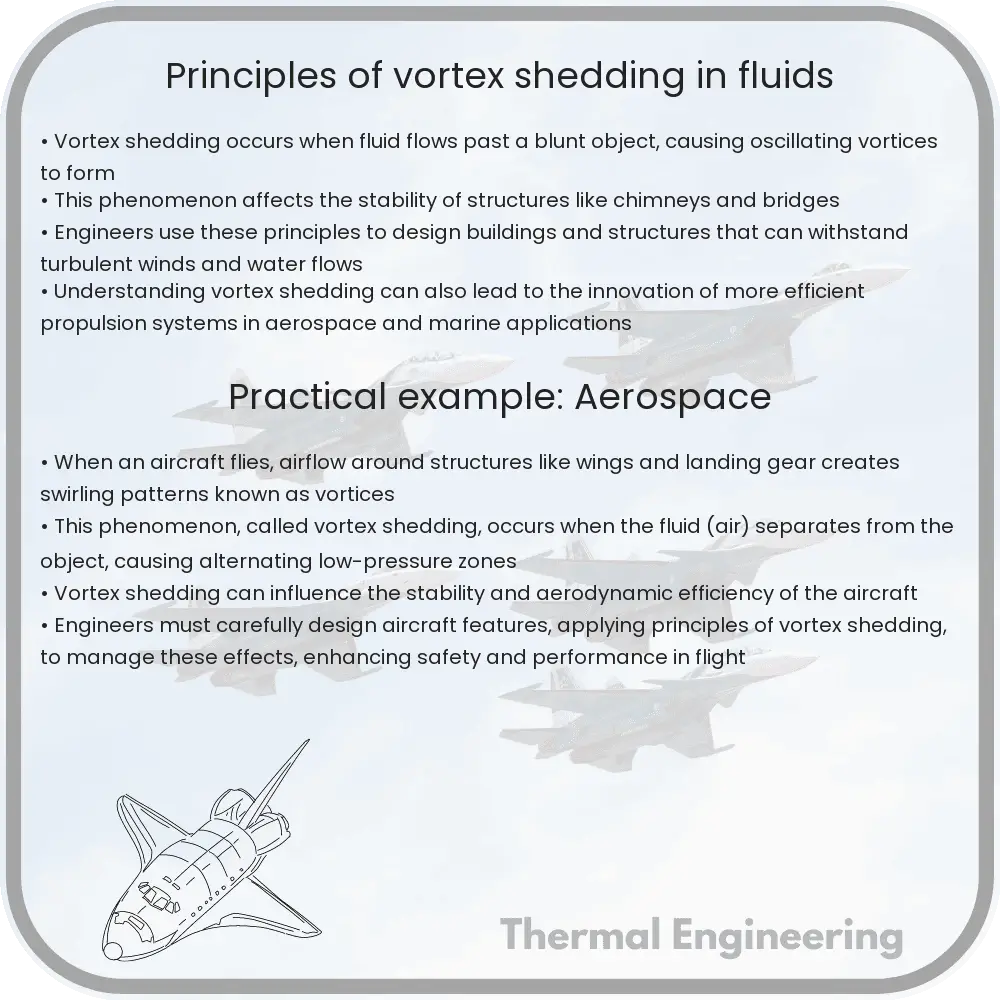Learn about vortex shedding, a fluid dynamics phenomenon, and its engineering applications.

Understanding Vortex Shedding in Fluid Dynamics
Vortex shedding is a fascinating and complex phenomenon in fluid dynamics that occurs when a fluid such as air or water flows past a blunt object. The process is characterized by the formation of alternating vortices or swirling patterns on opposite sides of the object. This article will explore the principles behind vortex shedding, its implications in engineering, and how understanding it can lead to more efficient designs in various engineering fields.
Basic Principles of Vortex Shedding
When a fluid flows past an object, it can start to separate from the surface of the object at certain points along its boundary. This separation of flow creates a series of low-pressure vortices behind the object. The formation and subsequent shedding of these vortices occur alternately from one side of the object to the other, which can set up a vibrating pattern known as vortex shedding.
The frequency at which these vortices shed is described by the Strouhal number (St), a dimensionless number given by the equation:
St = f * D / V
- f is the frequency of vortex shedding
- D is the characteristic dimension (typically diameter) of the object
- V is the velocity of the fluid
The Strouhal number is crucial for predicting the shedding frequency and understanding the resulting flow patterns around blunt objects. This understanding helps engineers in designing structures that can withstand or minimize the effects of fluctuating forces due to vortex shedding.
Effects and Applications in Engineering
Vortex shedding is not just a theoretical concept; it has practical implications in engineering. Here are a few examples:
- Structural Engineering: In the construction of tall buildings or bridges, engineers must consider the effects of wind loads. Vortex shedding can induce oscillations in structures, which, if aligned with the structure’s natural frequency, could lead to structural failure due to resonance. The Tacoma Narrows Bridge collapse in 1940 is a famous example of such a failure.
- Aerospace Engineering: In aircraft design, engineers need to ensure that tail wings and other surfaces are capable of handling the stress caused by vortex shedding at various speeds and angles of attack.
- Marine Engineering: For offshore platforms and ship hulls, the patterns of vortex shedding must be analyzed to prevent vibrations which might lead to fatigue in the structural components.
Controlling Vortex Shedding
Given the potential adverse effects of uncontrolled vortex shedding, engineers have developed multiple strategies to manage or suppress it:
- Vortex-Inducing Devices: Devices such as spoilers can be added to structures to alter the flow and reduce the formation of coherent vortices.
- Shaping the Object: Streamlining objects to alter the flow separation points and reduce the lift coefficient can significantly mitigate vortex induced vibrations.
- Tuning the Natural Frequency: By changing the stiffness or mass distribution of a structure, its natural frequency can be altered so it does not coincide with the frequency of vortex shedding.
Conclusion
Understanding vortex shedding is crucial for engineers across many industries. By applying this knowledge, engineers can design structures and devices that are safe, efficient, and less prone to the detrimental effects of fluid-structure interactions. The ongoing study of vortex shedding not only aids in improving existing designs but also inspires innovation in tackling new engineering challenges posed by complex fluid flows.
This basic introduction to the principles of vortex shedding in fluid dynamics illustrates its importance and applications. For engineers and designers, mastering this aspect of fluid mechanics is essential for optimizing performance and ensuring structural integrity in their projects.